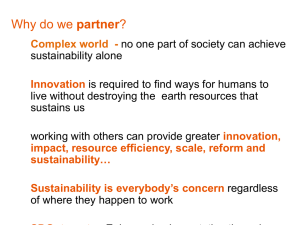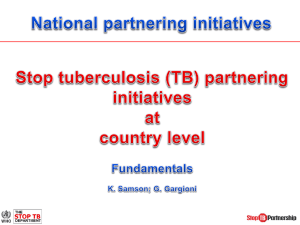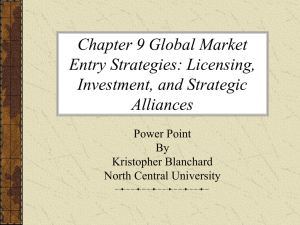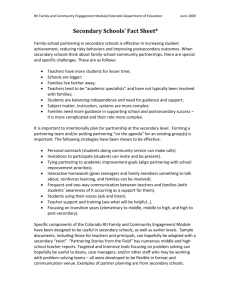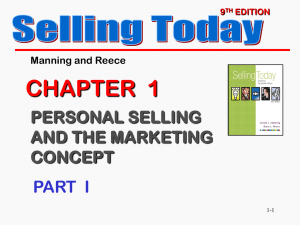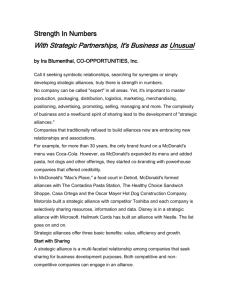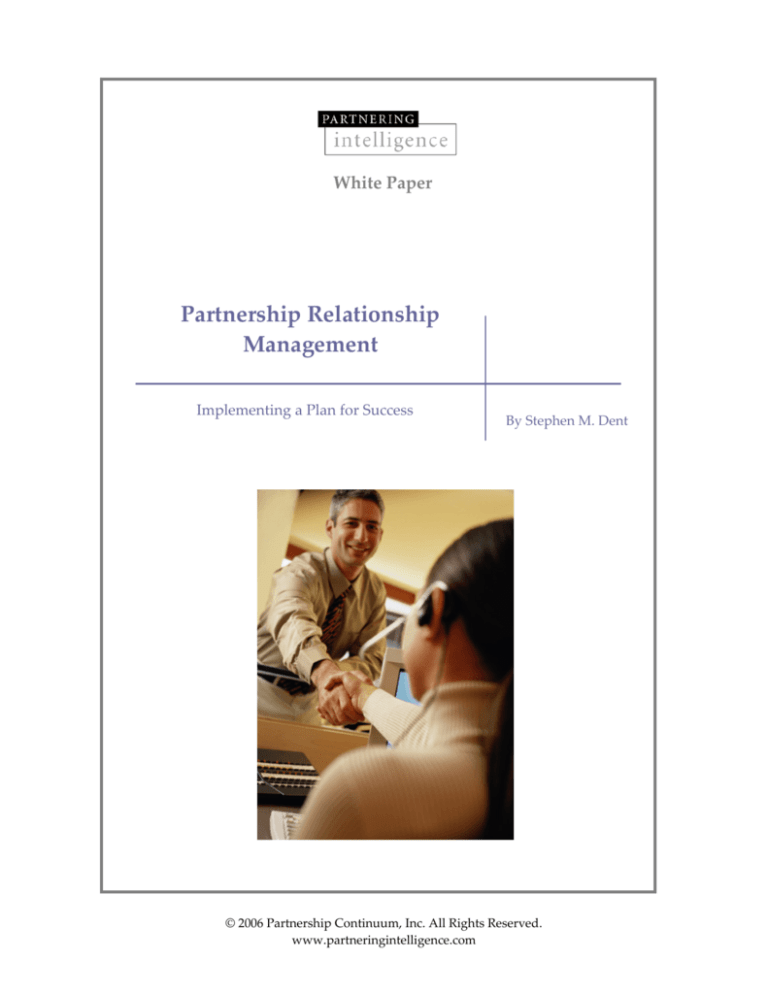
White Paper Partnership Relationship Management Implementing a Plan for Success
By Stephen M. Dent
© 2006 Partnership Continuum, Inc. All Rights Reserved. www.partneringintelligence.com Partnership Relationship Management: Implementing a Plan for Success 1 Executive Summary Organizations are struggling to react quickly to ever‐changing customer expectations and needs while struggling with shifting market needs and financial swings. Striving to outmaneuver competitors these days involves capitalizing on highly effective internal and external relationships that ensure the business has the capabilities to support its mission and evolving growth initiatives. The strategy of connectivity to other people and entities is now crucial for innovation and overall success. Businesses today must propagate connections that provide resources they don’t possess in house and enable them to move quickly to profit. Conducting business in the twenty‐first century, therefore, requires forming partnerships and strategic alliances—both internally and externally. Creating a partnering culture in your organization will foster collaboration among existing subcultures. Creating a partnering culture positions an organization to accrue four chief benefits: • Openness • Creativity • Agility • Resiliency These chief benefits enable business transformation and thus impact the bottom line. Smart partners win not only because of what they do but, even more importantly, from how they do it. They win from leveraging their connectedness and from valuing the building of relationship skills. Alliances and partnerships produce astonishing results—but only when information flows freely, people trust each other, and are loyal to each other and their mutual success. Operating from such a vibrant collaborative mind‐
set that forgets about getting the bigger slice of the pie requires interdependence that does not come naturally to any organization. This paper discusses the characteristics of effective partnership relationships and presents an outline for implementing a plan for success. It also provides a Relational Survey to help determine a partnership’s state of health and provides a Partner Relationship Management Assessment, both as tools for determining an organization’s starting point in relationship management. © 2006 Partnership Continuum, Inc. All Rights Reserved. www.partneringintelligence.com The ability to recognize strengths and acknowledge weaknesses is a cultural issue. The energies a culture drives from the people who live and work within the relationship structure will foretell success or failure.
Partnership Relationship Management: Implementing a Plan for Success 2 Characteristics of Effective Partnerships A partnership is where two or more people need to work together to accomplish a goal while building trust and a mutually beneficial relationship. This means the partnership is voluntarily agreed upon, built on the desire to have trust, and based on agreed‐upon mutual benefits. Effective partnerships have the following characteristics: (1) Partnerships are entered into voluntarily Partnerships cannot be forced. However, we often find ourselves in situations where we are “assigned” to partners—for example, when we are appointed to a project or task force, join an existing board of directors, work on a committee at a school, or volunteer to help plan the church picnic. In these cases, relationships can become true partnerships only when all involved have defined the goal or task, have identified the mutual benefits, and are committed to building trust. (2) Partners perceive themselves to be equal in power and accountability In a partnership, authority and title are meaningless in the delegation of tasks, decision‐making, and conflict‐resolution. The only factors that might make one partner’s perspective take precedence over another’s are greater knowledge or more experience. How roles and responsibilities are assigned depends on the demands of the situation and the particular competencies of the partners. (3) Partners have equal access to, and openly share, information and knowledge In a partnership, the emphasis is always on the task or outcome for which the partners came together in the first place. To that end, all partners need to have access to the same information. In corporate settings, individuals often operate according to the adage that “knowledge is power,” and they increase their power by hoarding information parceling out bits and pieces as needed. In a partnership, however, partners are not focused on power. All partners are perceived as equal and therefore willingly share information. This not only enhances the functioning of the partnership but also increases the quality of the outcome. Synergy and creativity result when people build upon one another’s information and ideas (4) All partners are perceived as equally valuable, albeit in different ways Partnerships come together when individuals require the contribution of others to accomplish a task or reach a goal. By definition, every partner has something of value to bring to the partnership, and that something is essential to the quality of the outcome. © 2006 Partnership Continuum, Inc. All Rights Reserved. www.partneringintelligence.com Typical Partnerships:
Strategic alliances Joint marketing partnerships Union‐
management relationships Mergers and acquisitions Board of directors Organizational executive leadership teams Organizational cross‐functional / departmental partnerships Public‐private partnerships Non‐profit / for‐profit partnerships Community‐
based partnerships Internal teams and departments Partnership Relationship Management: Implementing a Plan for Success 3 Therefore, every partner is acknowledged for the value of his or her contribution, and no one partner is viewed as more important than any other. (5) Partners look for opportunities to discover they are wrong When all partners are committed to the excellence of the outcome, they want to continually check that their perceptions, decisions, and actions will produce the best product or service. To that end, they welcome suggestions about how to do things differently and actively seek them out. Partners don’t want to be “right” or have the last word. They want to arrive at the best possible outcome or solution and are open to any and all information that will help them achieve it. (6) Partners seek out and support success for others Partners bring to a relationship an outlook of abundance. An individual with an abundant outlook believes that there is enough of everything available in the world for everyone to get what he or she needs. People who possess an abundant outlook can seek opportunities for others to succeed and can celebrate others’ successes because they know this does not detract from their opportunities to be successful as well. People whose outlook is one of scarcity feel that anything that goes to anyone else takes something from them. They therefore are unable to promote or support the success of others because they covet it for themselves. Such individuals have great difficulty working in partnerships. In a world that is connected and integrated by networks of information and knowledge, every person in the new economy holds the potential for generating new ideas and coming up with better structures, processes or systems for designing, producing, marketing, selling and distributing goods and services. Although a partnership may appear to be between faceless corporations, it is people who form and manage partnerships. They must have the skills—a high Partnering Quotient—to create a successful business relationship. These skills include: •
•
•
•
•
Openly self‐disclosing information and giving feedback Creating trust through actions and words Creatively resolving conflicts and solving problems Welcoming change Valuing interdependence © 2006 Partnership Continuum, Inc. All Rights Reserved. www.partneringintelligence.com If we partner, we get our personal, professional, and organizational needs met—at levels that are not possible in a competitive environment, let alone in organization cultures that actively encourage cutthroat behavior among leaders and employees. Partnership Relationship Management: Implementing a Plan for Success 4 The following “low PQ” characteristics can doom a partnership to failure: •
•
•
•
•
•
Withholding information Having low trust of others Desiring to win conflicts Relying on past history for decision‐making Maintaining the status quo and resisting change Valuing independence Each partnership is as unique as the people who comprise it. Even so, there are certain characteristics that all successful partnerships have in common: •
•
The people in the partnership have a keen sense of self in that they understand their own strengths and weaknesses They know what they want out of the partnership What is Partnership Relationship Management? Despite the word ʺrelationshipʺ in its name, Customer Relationship Management (CRM) is not really concerned with managing customer relationships but, rather, with managing data about a customerʹs buying habits and preferences. Of course, a company where one is a potential customer doesnʹt really care about its ʺrelationshipʺ with the customer. What it wants is another transaction from the customer. Thatʹs the whole objective of CRM: to generate another sale. Partner Relationship Management (PRM), on the other hand, really is about relationships. Itʹs about understanding the needs of one’s business partners and satisfying those needs to the best of one’s ability while building trust between the two parties. PRM, therefore, is much more complex than collecting data. An organization must learn to communicate with its partner, using self‐
disclosure skills to articulate its needs. It must know its personal trust strategies and then share those with the partner. The organization must build agreements that are mutually beneficial while working through the conflict that collaboration, by its very nature, causes. PRM also challenges people to change and focus on the future so they donʹt continually dwell on past glories and stay stagnant. It links one person or entity’s future with that of another—in a positive and exciting way. © 2006 Partnership Continuum, Inc. All Rights Reserved. www.partneringintelligence.com Imagine harnessing the brilliance of your workforce. Imagine learning from each other. Imagine being an innovation factory, turning out new and exciting ideas and products or services on a regular basis. Imagine having a workforce that is not just loyal but feels a sense of duty to the success of the organization. These are the goals that can be achieved in an effective partnership relationship. Partnership Relationship Management: Implementing a Plan for Success 5 Determine the State of Health of Partnership Relationships Are your partnerships—internal and external—healthy? The following Relational Survey and the 60‐Second Partner Relationship Management Assessment will help you collect objective data on the current state of your partnership relationships. Once the results have been tallied, pull your team together, review the results, and invite feedback. Any question in which the average score is three or less presents an issue that the team should discuss. Try to reach conclusions on why the team didnʹt do well in that particular area. Then look at the areas in which youʹre doing well. What are you doing that makes you successful in that area? How can the team use the knowledge gained from those successes to improve the areas in which the team is not doing as well? Be sure to give yourselves plenty of time to discuss each item. Finally, develop an action plan for improving those items that had low scores and celebrate your successes! RELATIONAL SURVEY Instructions: Think about a partnership youʹre involved in, or a team of which youʹre a member. Briefly reflect on your relationship. Then read each of the statements that follow. For each, write down your personal rating from 1 (not very well) to 5 (very well) in the blank spaces at the end. 1. How well did we build trust between us? _____ 2. How well did we solve conflicts between us? _____ 3. How well did we solve problems using new and creative techniques? _____ 4. How well did I get my important needs met in the partnership? ____ 5. How well did we share information between us? _____ 6. How well did we focus on future events vs. past mistakes? _____ 7. How well did we respect each otherʹs time? _____ 8. How well did we reinforce our vision with each other? _____ 9. How well did we monitor our relational expectations? _____ 10. How well did we rely on our partners to help us meet our objectives? _____ 11. How well did we give each other constructive feedback? _____ 12. How well did we reach decisions that were truly supported by everyone? _____ 13. How well did we address the ʺhardʺ issues? _____ 14. How well did we support each other outside of the partnership? _____ 15. How well did we celebrate our accomplishments as a team? _____ © 2006 Partnership Continuum, Inc. All Rights Reserved. www.partneringintelligence.com The survey works best if the information is gathered anonymously. Protecting the identity of respondents provides a safety zone for people who may not be comfortable openly disclosing their concerns. Cut and paste the survey into a document so you can print it out and distribute it to the members of your partnership or team.
Partnership Relationship Management: Implementing a Plan for Success Does your organization have a solid Partner Relationship Management (PRM) program in place? To find out, take this 60‐second PRM assessment. Simply answer each question ʺYesʺ or ʺNo.ʺ 60‐SECOND PARTNER RELATIONSHIP MANAGEMENT ASSESSMENT Adapted from Partner Relationship Management Training. Partner Relationship Management Assessment © 2002 Partnership Continuum, Inc. All rights reserved. 1. Do you have a jointly developed strategic framework in place with your partner(s)? 2. Have you documented your needs based on your businessʹs strengths and weaknesses and shared them with your partner(s)? 3. Do you have a measurement system in place to document and track your partnershipʹs mutual benefits? 4. Are relational expectations documented between you and your partner(s)? 5. Do you have a jointly developed partnership agreement in addition to any contractual agreements you may have? 6. Do the sponsors of the alliance meet at least twice a year in face‐to‐face meetings to review alliance progress and strategic relevance? 7. Do you measure the relational components of the alliance along with its economic benefits? 8. Is trust a formal indicator that is measured and regularly reported within your alliance? 9. Have the teams implementing the alliance received formal training on building relationships? 10. Have joint communications and symbols of the alliance been prominently displayed in public locations? Add up your ʺyesʺ and ʺnoʺ responses. If you have three or more ʺnoʺ responses, you do not have a PRM program in place. Find out more information about these 10 PRM aspects on the following page. © 2006 Partnership Continuum, Inc. All Rights Reserved. www.partneringintelligence.com 6 Partnership Relationship Management: Implementing a Plan for Success 1. Do you have a jointly developed strategic framework in place with your partner(s)? Having a jointly developed strategic framework is important for two reasons. First, it provides you and your partners with an opportunity to define and document a clear purpose for your alliance. Second, it builds joint ownership of the alliance. This is especially important when an alliance was conceived by one partner who then invited the other partner to join. 2. Have you documented your needs based on your businessʹs strengths and weaknesses and shared them with your partner(s)? Having your needs, strengths, and weaknesses documented provides an opportunity for your partners to get to understand you and your business better. It also provides your partners with information that can assist them in helping you meet your needs. 3. Do you have a measurement system in place to document and track your partnershipʹs mutual benefits? Partners often fail to put into place a measurement system to document and track the partnershipʹs benefits. When there is a perception that one partner is gaining benefits at the expense of the others, resentment builds, which leads to mistrust. Documenting and tracking the partnershipʹs benefits to each partner not only helps measure whether those benefits are being achieved, it also enables imbalances to be identified‐‐and rectified. 4. Are relational expectations documented between you and your partner(s)? Itʹs important that you document what is expected of all members of the partnership. Documenting such norms of behavior plays an essential role in maintaining the partnershipʹs culture. However, members of a partnership change over time. As members change, previous agreements, especially around relational expectations, can get lost in the shuffle. New members coming into the partnership must be briefed on the partnershipʹs culture so they have a clear understanding of what is expected of them. 5. Do you have a jointly developed partnership agreement in addition to any contractual agreements you may have? Partnership contracts tend to define only expected deliverables. Partnership agreements, on the other hand, lay out the strategic framework, behavioral expectations, roles and responsibilities, and tasks of the alliance‐‐in other words, how the partners are going to interact with each other. Hereʹs another way of thinking about it: A partnership agreement focuses mainly on process; a contract, on output. © 2006 Partnership Continuum, Inc. All Rights Reserved. www.partneringintelligence.com 7 Partnership Relationship Management: Implementing a Plan for Success 6. Do the sponsors of the alliance meet at least twice a year in face‐to‐face meetings to review alliance progress and strategic relevance? For alliances to succeed, the leaders of the partnering organizations need to be actively involved. Absent leadership dooms alliances. Itʹs critical, therefore, that alliance sponsors meet at least twice a year to discuss alliance issues and to plan for future activities. 7. Do you measure the relational components of the alliance along with its economic benefits? Most alliances do a good job of measuring their economic indicators‐‐the additional revenue generated by the alliance, the allianceʹs expenses, the amount of time spent on managing the alliance, and other cost‐related functions. What alliances donʹt do as well is to measure the relational aspects of the alliance‐‐levels of trust, frequency of communication, use of creativity in problem‐solving, ability to resolve conflicts, and so on. The relational aspects are as important to the overall success of your alliance as its monetary benefits. In fact, good relations within the alliance ensure that the monetary benefits will follow. 8. Is trust a formal indicator that is measured and regularly reported within your alliance? Trust is rarely monitored in alliances, and yet itʹs key to their success. People do what theyʹre measured to do. If trust is measured, trust will happen. 9. Have the teams implementing the alliance received formal training on building relationships? Alliance and partnership building is an unnatural act for most of us. Weʹre educated, socialized, and rewarded in ways that reinforce our belief that we must look out after #1‐‐as our business behaviors all too often illustrate. When push comes to shove, we revert back to these behaviors because they are comfortable and ʺfeel right.ʺ But they are not the behaviors that make partnerships successful. People must learn the skills to build successful partnerships. These skills are those identified in Partnership Continuumʹs Six Partnering Attributes: Self‐
Disclosure and Feedback, Win/Win Orientation, Ability to Trust, Future Orientation, Comfort with Change, and Comfort with Interdependence. Formal training in these skills gives people the tools they need to change old behaviors and to build healthy, long‐lasting‐‐and profitable‐‐alliances. 10. Have joint communications and symbols of the alliance been prominently displayed in public locations? After the alliance has been established, you must communicate its importance to your organization. You communicate this message through joint communications and by displaying symbols of the alliance in locations where people can see them. © 2006 Partnership Continuum, Inc. All Rights Reserved. www.partneringintelligence.com 8 Partnership Relationship Management: Implementing a Plan for Success 9 The Steps to Partnership Relationship Management An organization’s structure describes how accountability for results and corresponding work tasks are distributed and managed in an enterprise. It involves job design and organization design. Getting it right is a tall order. If partnering is to become “how things are done around here” it must be baked into every job. It must be included as a documented criterion in every job description. Partnering is both a job input (a set of behavioral characteristics) and a job output (products, services, and the partnerships and strategic alliances needed to accomplish the organization’s purpose). Partnership relationship management requires investing money, time, and energy. Step One. The first step in building a partnership relationship management plan is to create a grounded, compelling strategic framework. This framework will interconnect the ethereal energies with the material outputs, creating an interactive, self‐reinforcing system. A strategic framework has three principal components. (1) Vision. This describes the desired destiny of the organization—not a point or timeline but, rather, a navigational reference point guiding the business for the long haul. It is a short, compelling description of a value outcome, a vision that reflects the passion of the shareholders and defines the meaning they give to their enterprise. (2) Mission. This statement describes how an organization will achieve its vision. It identifies an entity’s area of expertise. (3) Strategic directions. A strategic direction specifies a broad area of organizational focus, the specific things the entity needs to do over the next two or three years to achieve its mission. Collectively, the strategic directions define at a high level how the organization intends to allocate its resources (people, money, time, and technology). Step Two. The next step is to create a partnering culture. This is a two‐
pronged task. It starts with creating partnering capabilities in your organization’s people and continues with building a partnering infrastructure to make sure the organization’s structure is aligned both with its partnering philosophy and with its partnering processes. Businesses that embed such a partnering culture within their organizations will have the relationship skills they need—both in their leaders and their employees—to weather the storms without fear. This culture enables an organization to be poised to take advantage of an ever‐changing marketplace. © 2006 Partnership Continuum, Inc. All Rights Reserved. www.partneringintelligence.com Partnering culture springs mainly from how leaders behave. Culture by evolution happens when no deliberate thought or design is applied to the configuration of an organization’s culture. Culture by design happens when leaders sit down and formulate a partnering culture and then rigorously communicate and live by its tenets. Partnership Relationship Management: Implementing a Plan for Success 10 Step Three. The next step is to choose a partner and build a partnership that will enable your organization to move to: • Collaborative creativity • Transformation • Agility Smart partners aim first at expediting The ability to partner successfully results in a internal alliances among their diverse workplace where people want to stay and to functions and second at extending the same which they will contribute their best talents. partnering expertise externally to force The members of a partnering culture are mutually beneficial relationships with recognized and rewarded for displaying the customers, suppliers, and other companies. partnering behaviors that deliver results for everyone involved. Acquiring the Necessary Expertise for PRM Unfortunately, the steps described above are all unnatural acts. Therefore, the act of transforming an organization culture is messy and complex and requires leaders to exemplify their strongest relationship abilities. For many businesses, this is the point at which every instinct signals people to hunker down and get back to achieving tasks—at the expense of the relationship. Partnership Continuum, Inc., through extensive research over nearly two decades, developed a workable system for building effective partnerships and implementing partnership relationship management plans. We provide unique strategies focused on organization design and development, leadership development, and employee learning and development. We can help: • Create effective vision, mission and strategic directions • Reconfigure job descriptions to incorporate partnering • Ensure an organization’s structure is aligned with its partnering philosophy and its partnering processes • Teach you how to identify and hire people with partnering competencies and how to increase your people’s partnering capabilities • Enable you to increase your comfort with change, your ability to trust, your comfort with interdependence, and your comfort with self‐disclosure and feedback, • Enable you to increase your win/win orientation, for conflict‐
resolution and problem‐solving in a collaborative manner that consistently creates winners all around • Strengthen the leadership skills of your key people We have a wide range of services and products to support these strategies and a deep experience and insights to bring to your unique situation. © 2006 Partnership Continuum, Inc. All Rights Reserved. www.partneringintelligence.com Although the short‐term effect of an imbalance between achieving tasks and building relationships may seem insignificant to leaders, the long‐term impact on a business can be deadly. Partnership Relationship Management: Implementing a Plan for Success About the Author Stephen M. Dent, founder of Partnership Continuum, Inc., is a pioneer in Partnering Intelligence theory, research and application. His first book, Partnering Intelligence: Creating Value for Your Business by Building Strong Alliances (Davies‐Black publishing, 1999), describes how Smart Partners build effective internal and external business alliances that create sustainable competitive advantage. This book was listed as one of the top 30 business books for the year 2000. His most recent book is Powerhouse Partners: A Blueprint for Building Organizational Culture for Breakaway Results (Stephen M. Dent and James H. Krefft, Davies‐Black Publishing, 2004). He has over 20 years’ experience helping companies improve performance and operating margins through strategy, quality, process and partnership‐improvement methods. Prior to founding Partnership Continuum, Inc., Stephen was a Partner and Senior VP for Six Sigma‐Qualtec, where he delivered quality, process improvement, and partnership workshops. He is a sought‐after business consultant and keynote speaker. About Partnership Continuum, Inc. In the twenty‐first century, businesses that develop, sustain, and profit from partnerships faster and better will attain organizational success. At the core of any successful business are people. After all, businesses don’t partner; people do. Developing the Partnering Intelligence of people and organizations is what we do. Partnership Continuum, Inc. mobilizes your relationships with employees, customers, suppliers, and even competitors in surprising and rewarding ways. Our unique and innovative programs and products lead to higher productivity and stronger relationships enhancing your partnering capability through building trust, positive exchanges, respectful interactions, beneficial outcomes, future potential, and leadership excellence. Visit www.partneringintelligence.com for more information about our corporate and leadership training programs for Partnering Intelligence, the Six Partnering Attributes, and a partnering culture or contact us at 612.375.0323 or sdent@partneringintelligence.com to discuss how we can impact your organization’s effectiveness in building smart alliances. © 2006 Partnership Continuum, Inc. All Rights Reserved. www.partneringintelligence.com 11


